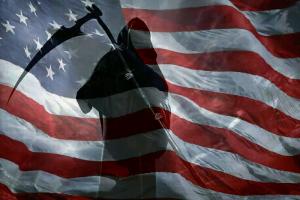 Yes, I know The Life of Brian is irreverent! But there’s nothing quite like a jolly good satire to make some pretty clever statements on love, life and the universe. The more conservative among us might read TLOB as a mockery of the sacrosanct, but I don’t see it that way – obviously. It’s a very intelligent critique of how daft we are. How seemingly incapable we are of understanding the difference between spiritual transcendence and hot emotional surges; between saving doctrines and institutional policy; between God and the religious elite; between a Zion community governed by Christ and a racially homogenous right-wing middle-class community where the only difference between us is the square footage of our houses and the make and model of our cars.
Yes, I know The Life of Brian is irreverent! But there’s nothing quite like a jolly good satire to make some pretty clever statements on love, life and the universe. The more conservative among us might read TLOB as a mockery of the sacrosanct, but I don’t see it that way – obviously. It’s a very intelligent critique of how daft we are. How seemingly incapable we are of understanding the difference between spiritual transcendence and hot emotional surges; between saving doctrines and institutional policy; between God and the religious elite; between a Zion community governed by Christ and a racially homogenous right-wing middle-class community where the only difference between us is the square footage of our houses and the make and model of our cars.
So here is poor Brian, who in some mindless pursuit by the masses through the streets of Jerusalem, accidentally drops his shoe. Thinking better of returning to pick it up, the chasing devotees discover it lying in the sand and it suddenly takes on a life of its own.
I intend to demonstrate, liberally using the most esteemed works of Bush (1973) and White & White (1980) and Monty Python (1979) that the church’s historical racial statements are much akin to Brian’s lost shoe. Mormonism’s racist ‘doctrine’ is akin to a single sandal – constructed with the materials of the day, reflecting the fashion of the time, lying unclaimed in the dust – missing its pair. It was then picked up by the rearguard and was transformed through equivocation, lies, deceit, bad science, poor theology, and a jolly good dose of political context into a defining feature of our religious life. That we still need debate the origins of this horrific and violent ‘doctrine’ is indicative of how extremely silly we religious folk can be. I’m not at all suggesting that there is no revelation and no prophecy and that certain people are not capable of interpreting the mind and will of God. I’m suggesting that we are in for some disappointment when we cling to nonsense notions which suggest that religious leaders are incapable of messing things up. Yes, yes – I know – Joseph said that the Lord won’t permit the prophet to lead the church astray, but he didn’t say that the church’s lack of understanding of the scriptures, the gospel, the atonement and Zion wouldn’t cause themselves to go astray!
So here’s a potted history for those of you who want a summary. I’m hoping that it will make its way to the LDS Newsroom where the corporation will be able to finally answer those ‘we don’t know’ questions that appeared in the 29 February press release! But then, if they haven’t read the many, many fine treatments from intellectuals on this subject over the years they are rather unlikely to listen to a brown girl from New Zealand.
The Joseph Smith Period
(Liberally lifted from: Bush, L (1975) Mormonism’s Negro Doctrine: An Historical Overview. In Dialogue: A Journal of Mormon Thought. Spring 1973.
1831: WW Phelps opens mission in Missouri and includes ‘Negroes’ among those who might be recipients of the message.
1832: Black man, Elijah Abel baptized.
1832: Allegations launched at the church that they were ‘tampering with slaves’ and inciting insurrection – this is a legal violation of Missouri law.
1833: Phelps’ article in Evening and Morning Star misinterpreted by angry Missourians as in invitation to blacks to immigrate to the state to become Mormon.
1833: Phelps’ retracts statement and publishes an article stating the opposite. I.e. Don’t come to Missouri if you are black and don’t become a Mormon if you are black.
1833: Phelps’ attempts to set Missiourian minds at ease leads nowhere and the Star press is destroyed by mobs.
1833: Joseph’s revelation, “it is not right that any man should be in bondage to another.”
1834: Church worried about slave insurrection and warns members against inciting such.
1835: The church’s official position on slavery. Avoids a political debate about the morality of slavery but endorses government as arbiters of such debates. Reiterates that it is not lawful to “interfere with bond-servants” or to preach and baptize them without the permission of their masters. Proselytizing to blacks therefore restricted.
1836: Elijah Abel ordained an elder.
1836: National debate on abolitionism – Joseph Smith objects to abolitionism. Five reasons:
1) America would be overrun by blacks and this will threaten to violate chastity and virtue of nice white ladies.
2) Pious men in the South loved it – and they should know.
3) North and South should keep out of each other’s business.
4) Sons of Ham (blacks) cursed by Jehovah to be servants.
5) Biblical precedent for slavery
Smith’s and Cowdery’s arguments and theories mirror those held more generally. Their thinking a reflection of the time including 4 & 5 courtesy of Jerome and St Augustine (around 300-400AD ish).
1836: Elijah Abel a licensed elder.
1836: Elijah Abel ordained a seventy.
1840: First Presidency proclaims universality of Mormonism – a religion for all.
1842: JS agrees with John C. Bennett, non-Mormon abolitionist, on “Universal liberty, to every soul of man”, and on the injustices experienced by abolitionists. JS comes out to church in letters as ‘anti-slavery’ but denies he is an abolitionist.
1842: JS writes in his journal that slaves should be “set free…and give them equal rights.”
1844: JS dies
1844: Orson Pratt comes up with the, ‘some spirits not valiant in the pre-existence and were cursed as black’ theory.
Joseph Smith Summary
Anti-abolitionist
Anti-slavery
Believed in the curse of Ham
Allows ordination of black man
Brigham Young
1845: Publishes an anti-abolitionist statement on the basis of ‘The curse theory’.
1849: Earliest record of a church decision to deny the priesthood to Negroes.
1852: “Any man having one drop of the seed of Cain… in him cannot hold the priesthood and if no other Prophet ever spake it before I will say it now in the name of Jesus Christ I know it is true and others know it.
1852: Signs an act as Utah governor legalizing both Negro and Indian slavery with provisions of ‘humane’ treatment.
1854: “When all the other children of Adam have the privilege of receiving the Priesthood and of coming into the Kingdom of God, and of being redeemed from the four quarters of the earth, and have received their resurrection from the dead, then it will be time enough to remove the curse from Cain and his posterity”.
1859: Declares – “The Lord put a mark upon Cain, which is the flat nose and the black skin…they should be the “servant of servants.”
1859: Blacks characterized as: “uncouth, uncomely, disagreeable in their habits, wild, and seemingly deprived of nearly all the blessings of intelligence that is bestowed upon mankind”.
1863: Reiterates the ‘curse can’t be removed’ ‘doctrine’
After the civil war: “…when all the rest of the children have received their blessings in the holy priesthood, then that curse will be removed from the seed of Cain, and they will come up and possess the priesthood.”
Brigham Young Summary
Pro-slavery
Anti-abolitionist
Believes in the curse of Ham
Declares that blacks can’t have priesthood because of curse
Doesn’t believe blacks have a right to temple ordinances
The problem of Elijah Abel
1879: Story goes around the church that JS said blacks could have the priesthood.
John Taylor goes to Zebedee Coltrin for clarification.
Coltrin says, ‘No, JS told me negroes have no right to PH and as President of Seventy I dropped Abel from quorum of seventy’.
Joseph F Smith disagrees and affirms Abel not dropped. Abel confirms Coltrin had ordained him as a seventy.
Abel petitions John Taylor unsuccessfully to be able to go to the temple. JT sends Abel on a mission. He dies 1 year in.
WW gets petitions from Jane James (a black woman) to receive temple ordinances. Petition taken to QOT and JFS argues that JS had ordained Abel so perhaps OK. George Q Cannon disagrees. WW eventually allows her to go to the temple under ‘special circumstances’.
GQC says: Joseph told me, ‘ The seed of Cain could not receive the PH’, but WW says, ‘I was an apostle under him for 5 years and never heard him say this’.
GQC denies right of white woman previously married to a black man to be sealed to her 2nd white husband.
GQC denies priesthood to a white man married to a black woman.
Lorenzo Snow never attributes “Negro doctrine” to Joseph Smith.
1885: BH Roberts sparks the ‘Egyptus myth’ in the Contributor.
1900: GQC using the ‘Egyptus’ myth in several First Presidency addresses.
1902 Joseph F. Smith affirms: Elijah Abel ordained a seventy and received a patriarchal blessing in days of JS.
1907: First Presidency declares: “No one known to have in his veins negro blood, (it matters no how remote a degree) can either have the priesthood in any degree the blessings of the Temple of God no matter how otherwise worthy he may be.”
1908: After 30 years of saying ‘Yes, Abel was ordained to PH’, JFS suddenly announces (without references) that Abel’s ordination had been declared null and void by the Prophet himself.
JFS alleges that WW refused temple ordinances to Abel – but WW didn’t become president until 5 years after Abel died!
1912: First Presidency use GQC’s claim that JS taught that the PH was denied to blacks.
POGP justification becomes embedded in explanations as to why no PH for blacks.
1931: Joseph Fielding Smith provides a theoretical foundation for policies based on history and POGP theory.
1947: First Presidency letter, “The rule of the church as heretofore followed has been set forth by the early Church leaders. You will find a discussion thereof in Brother Joseph Fielding Smith’s book, ‘The Way to Perfection, ‘chapter 16”. This book includes the quote (in speaking of Joseph Smith) “We all know it was due to his teachings that the Negro today is barred from the Priesthood.”
A quote from the above book states: “Not only was Cain called upon to suffer, but because of his wickedness – he became the father of an inferior race.”
Dropping the Doctrine
Lifted liberally from: White, O. & White D. (1980) Abandoning an Unpopular Policy: An Analysis of the Decision Granting the Mormon Priesthood to Blacks. Sociological Analysis, 3:231-245.
1951: First Presidency declares priesthood denial to be doctrine – not policy.
1954: Mark E Petersen in a BYU address: “Is there reason then why the type of birth we receive in this life is not a reflection of our worthiness or lack of it in the pre-existent life?…can we account in any other of way for the birth of some of the children of God in darkest Africa, or in flood-ridden China, or among the starving hordes of India, while some of the rest of us are born here in the United States? We cannot escape the conclusion that because of performance in our pre-existence some of us are born as Chinese, some as Japanese, some as Indians, some as Negroes, some as Americans, some as Latter-day Saints. These are rewards and punishments, fully in harmony with His established policy in dealing with sinners and saints, rewarding all according to their deeds.
1958: According to a leading Apostle the saints were finding their church “guilty of a great injustice in the flood of correspondence from all parts of the church”.
1958: Mormon Doctrine by Bruce R. McConkie published reiterating ‘the curse mythology as doctrine’. “Negroes in this life are denied the priesthood; under no circumstances can they hold this delegation of authority from the almighty. The gospel message of salvation is not carried affirmatively to them… “Negroes are not equal with other races where the receipt of certain spiritual blessings are concerned…” (Mormon Doctrine, 1958, p. 477)
1958: McConkie – “Certainly the caste systems in communist countries and in India, for instance, are man made and are not based on true principles. “However, in a broad sense, caste systems have their root and origin in the gospel itself, and when they operate according to the divine decree, the resultant restrictions and segregation are right and proper and have the approval of the lord. To illustrate: Cain, Ham, and the whole Negro race have been cursed with a black skin, the mark of Cain, so they can be identified as a caste apart, a people with whom the other descendants of Adam should not intermarry.”
(Mormon Doctrine, 1958, pp. 107-108)
1963: Hugh B Brown sympathetic to Civil Rights movement.
1963: Nigerian government deny missionary visas.
1964: Church charged with violation of the 1964 Civil Rights Act over Boys Scouts programme which required patrol leaders to be priesthood holders. This meant black scouts could not be patrol leaders.
1965: NAACP urges foreign governments to deny visas to Mormon missionaries for promulgating a doctrine of black inferiority.
Late 60’s: Standford sever ties with BYU.
Public relations issues ensue, sparking aggressive PR campaigns.
Brazilians converts – many with black ancestry want to go to the temple.
Outspoken critics of the ban, John Fitzgerald, Bryon Marchant, and C.D. McBride are excommunicated.
Genesis Group formed.
1978: Priesthood made available to “All Worthy Males” under Spencer W. Kimball.
1978: Bruce R. McConkie – “And all I can say to that is it is time disbelieving people repented and got in line and believed in a living, modern prophet. Forget everything that I have said, or what President Brigham Young or President George Q. Cannon or whomsoever has said in days past that is contrary to the present revelation. We spoke with a limited understanding and without the light and knowledge that now has come into the world.”
2012: BYU Professor Randy Bott reiterates the Negro Curse Theory to the Washington Post as a justification for the priesthood ban.
2012: The church issues as a news release the following statement: “For a time in the Church there was a restriction on the priesthood for male members of African descent. It is not known precisely why, how, or when this restriction began in the Church but what is clear is that it ended decades ago. Some have attempted to explain the reason for this restriction but these attempts should be viewed as speculation and opinion, not doctrine. The Church is not bound by speculation or opinions given with limited understanding.”
And so, after an exhausting but not necessarily exhaustive treatment of the history of the Mormon priesthood ban we are left with a number of reasonable conclusions that we could make. But I prefer to defer to Monty Python who very aptly described what happens when we mere mortals don’t quite get Jesus’ message and instead end up slightly fuddled (x1 curse word in here – apologies). In the end perhaps we need to be extraordinarily careful that we don’t just allow ourselves to be lead by the nose, its not good for us and its not good for our leaders either.
If you want to listen to some talking heads featuring moi (and haven’t already) you can catch the Mormon Matters Podcast discussion about it as well!











